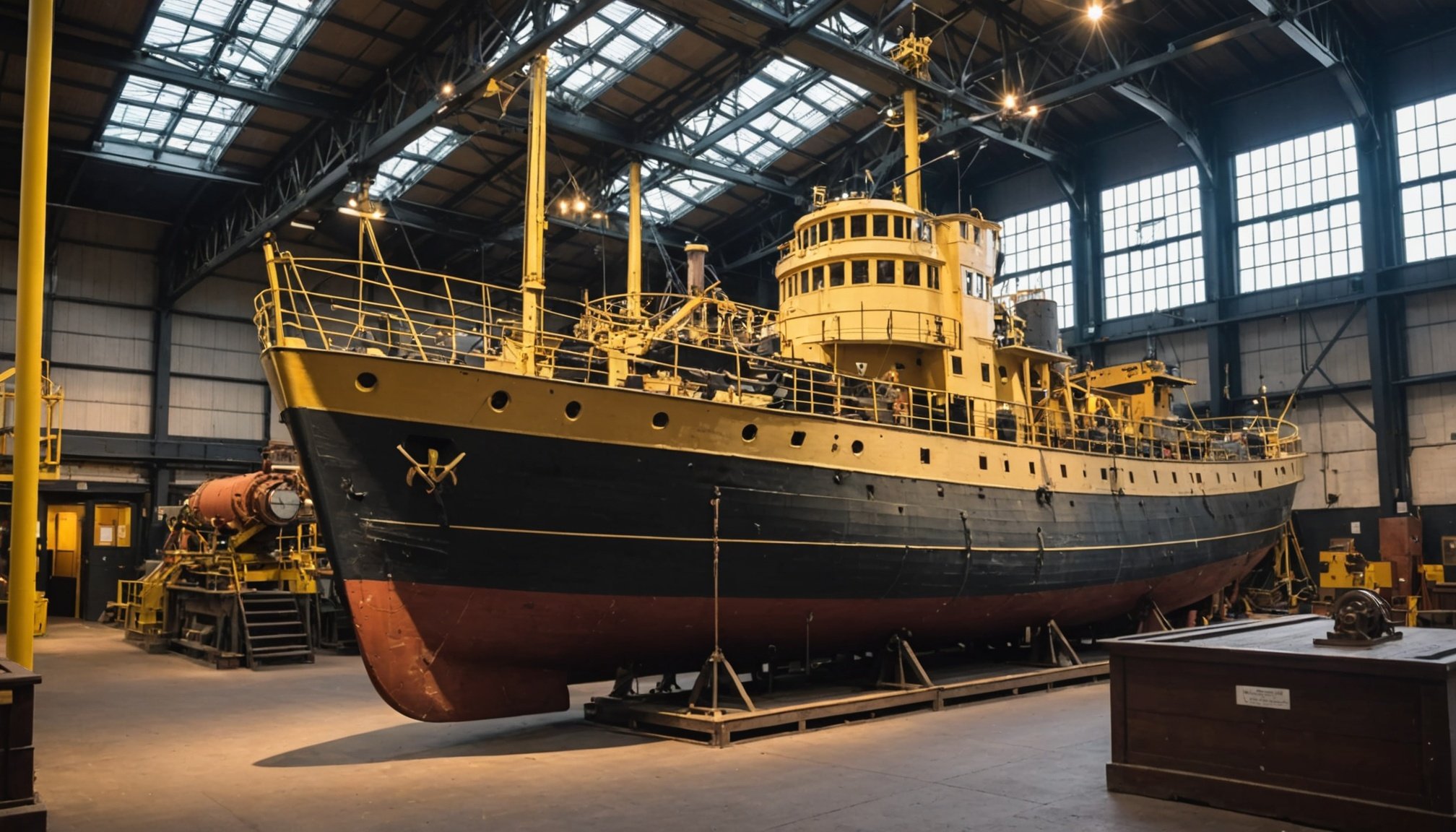Overview of Glasgow’s Historic Shipbuilding Museums
Glasgow’s rich maritime heritage springs from its historical roots as a significant center for shipbuilding. At its zenith, the shipbuilding industry thrived along the River Clyde, turning Glasgow into a renowned hub that contributed immensely to the global maritime landscape. Today, the legacy of this prosperous era is meticulously preserved through various Glasgow shipbuilding museums. These institutions play a crucial role in conserving the historical significance of shipbuilding activities that once dominated the city’s shores.
Key museums, such as the Riverside Museum and The Tall Ship Glenlee, provide insightful glimpses into the past. They offer extensive collections and exhibits that underscore the city’s pivotal role in maritime engineering. By showcasing shipbuilding artifacts, these museums retain the cultural essence and illustrate the evolution of maritime technology over the centuries.
Also read : Experience enchanting hot air balloon adventures above the stunning english countryside
The importance of these museums extends beyond mere historical preservation. They serve as educational platforms that enlighten the public about the intricate craftsmanship and innovative spirit that fueled Glasgow’s economic and industrial growth. Through interactive exhibits and storytelling, visitors of all ages can appreciate the industry’s enduring impact on the cultural fabric of the city. The efforts of Glasgow shipbuilding museums in safeguarding this heritage ensure that the narrative continues to inspire future generations.
Must-See Museums and Their Guided Tours
Exploring Glasgow’s must-see museums offers an enriching dive into the city’s shipbuilding legacy through engaging guided tours. These experiences are designed to deepen appreciation for the intricate history.
Also read : Uncover england”s legendary battlefields: your comprehensive guide to the top guided tours
The Riverside Museum
The Riverside Museum is noted for its dynamic shipbuilding exhibits, making it a primary attraction. Tours here meticulously narrate the transformation of maritime technology. To accommodate all, guided tours run regularly throughout the week. Visitors can secure their spots with advance online bookings, ensuring a seamless experience.
The Tall Ship Glenlee
Onboard this superbly preserved ship, guided tours provide authentic maritime adventures. Engaging guides weave tales of the ship’s storied past and detailed craftsmanship. Tours are offered daily, with special events enhancing the traditional experience. Online booking is recommended due to high demand.
The Hunterian Museum
The Hunterian Museum presents a diverse array of exhibits, linking scientific exploration with nautical history. Guided tours showcase unique items that bridge Glasgow’s maritime past with broader historical contexts. Regularly scheduled tours are detailed on their website, facilitating convenient bookings.
Embarking on these guided tours assures visitors a multifaceted understanding of shipbuilding’s impact, enriched by knowledgeable guides and unparalleled exhibits. By planning ahead, visitors can maximize their experience, ensuring they leave with a deeper connection and understanding of Glasgow’s maritime heritage.
Historical Context of Shipbuilding in Glasgow
Glasgow’s shipbuilding history is woven into the fabric of the city, illustrating its profound impact on both the local economy and cultural identity. During its peak in the late 19th and early 20th centuries, the maritime industry in Glasgow was a powerhouse, producing a significant portion of the world’s ships. The sector was pivotal in transforming the city into an industrial giant, providing employment and skills development to thousands.
The industry’s rise catalysed Glasgow’s economic growth, with the River Clyde becoming synonymous with shipbuilding excellence. Ships like the famous Queen Mary and Queen Elizabeth were born along these banks, marking prestigious landmarks in the city’s rich narrative. The cultural impact of this legacy is still apparent today, with Glasgow shipbuilding influencing generations of innovators and craftspersons.
Efforts to commemorate this industry are evident through numerous shipbuilding museums, where the historical significance of maritime endeavors is celebrated. These venues offer a glimpse into the past, allowing visitors to appreciate the craftsmanship and ingenuity that defined an era. By maintaining this legacy, Glasgow shipbuilding museums not only safeguard artifacts but also ensure that the cultural impact of the maritime industry endures, inspiring future appreciators of nautical heritage.
Highlighted Exhibits and Experiences
Exploring Glasgow’s shipbuilding museums reveals a treasure trove of must-see exhibits and engaging interactive experiences. These displays not only preserve shipbuilding artifacts but also bring the city’s maritime legacy to life.
Among the noteworthy exhibits, the Riverside Museum showcases scale models, authentic memorabilia, and a rich collection of shipbuilding artifacts. Visitors can encounter the intricacies of ship design while admiring the materials and technologies that shaped Glasgow’s reputation as a maritime powerhouse. Interactive experiences, such as virtual reality simulations, allow enthusiasts to embark on historic voyages, merging education with hands-on learning.
Unique workshops offered by the museums further enhance this immersive journey. Visitors can participate in shipbuilding demonstrations, gaining insight into the craftsmanship and skills that fueled the city’s industrial ascent. The Tall Ship Glenlee presents curated maritime adventures, where guests can learn about life on board through storytelling and participatory activities.
These carefully curated exhibits and experiences not only underscore the historical importance of shipbuilding in Glasgow but also create a memorable exploration for visitors of all ages. The museums’ dedication to blending historical authenticity with modern interactive methods ensures a captivating insight into the city’s maritime past.
Visitor Testimonials and Reviews
Exploring the opinions of past attendees offers valuable insight into the visitor experiences at Glasgow’s shipbuilding museums. These accounts not only reflect testimonial details but also suggest nuances in both the highlights and areas for improvement.
Positive Visitor Experiences
Visitors frequently commend the museums for their comprehensive displays and immersive interactive experiences. The combination of authentic artifacts with storytelling effectively rejuvenates Glasgow’s maritime legacy. Many express that the shipbuilding exhibits exceed expectations, offering a captivating glimpse into the city’s storied past.
Common Critiques
While feedback is predominantly favorable, some visitors note challenges such as crowded exhibits during peak periods. This occasionally results in limited engagement with certain displays. To mitigate this, potential updates in crowd management and exhibit accessibility could enhance the visiting experience.
Recommendations from Past Visitors
Visitors consistently recommend booking guided tours in advance to maximize the must-see exhibits and interactive options offered by each museum. Seasoned attendees suggest visiting during off-peak hours for a more leisurely exploration. For those wishing to delve deeper into maritime history, engaging with knowledgeable museum guides is advised. These tips, derived from firsthand experiences, can significantly enrich one’s journey through Glasgow’s maritime heritage.
Tips for an Enriching Visit
Embarking on a journey through Glasgow’s shipbuilding museums can be a deeply rewarding experience. To ensure visitors make the most of their exploration, a bit of preparation is key. Here are some essential visitor tips to enhance your visit to these historic sites.
Begin by planning your visit according to the available educational resources. Each museum offers brochures and guides that provide insightful information about their exhibits. Delving into these before your visit can enrich your understanding and appreciation of the displays.
Next, consider crafting a suggested itinerary for your museum visits. Allocating sufficient time for each venue ensures you can fully immerse yourself in the must-see exhibits and interactive experiences. For instance, starting at the Riverside Museum and following up with a visit to The Tall Ship Glenlee allows a seamless flow from land to sea-based exhibits.
For those keen to delve deeper into the city’s maritime heritage, tapping into additional resources, such as books or documentaries available online, can provide further context and depth to your visit. These visitor tips are designed to ensure you leave Glasgow’s shipbuilding museums with a comprehensive understanding and newfound appreciation for this pivotal aspect of the city’s history.











